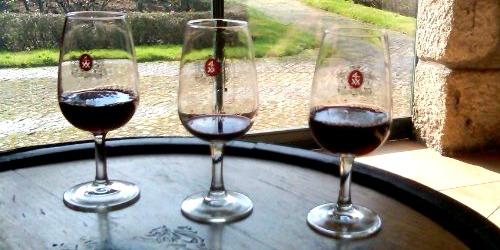 Porto (or Oporto) is the home of port wine. In the early 1700′s England was at war with France and so the people of England (longing for the delicious wine of France) searched for an alternative. They discovered the wines of Portugal, but quickly realized that the wine was spoiling before it made the long trip from Portugal to England. So the clever Brits devised a method of fortifying the wine to increase its longevity.
Porto (or Oporto) is the home of port wine. In the early 1700′s England was at war with France and so the people of England (longing for the delicious wine of France) searched for an alternative. They discovered the wines of Portugal, but quickly realized that the wine was spoiling before it made the long trip from Portugal to England. So the clever Brits devised a method of fortifying the wine to increase its longevity.
They added a neutral grape spirit, called aguardente, which stops fermentation and keeps more of the natural sugar intact. The wines are then aged in barrels (or bottles depending on the style ). Now we have white port, ruby port, tawny port, late bottled vintage, colheita, blends, and vintage port.
In the early days of the port industry, the grapes were grown in the Douro and then sent to Porto to be made into wine and aged in the city’s cellars, which are called caves. This was all done in Porto so that the finished product could be easily shipped the short distance down the river to the Atlantic and then on to England. Now, while the grapes are still grown in the Douro Valley, the rest of the process is completed there as well, leaving many of Porto’s wine caves just for show or to welcome people who want to come taste the port wine. In fact, port tasting is the main activity in Porto and one you should not skip.
The port houses of Porto aren’t actually in Porto. They’re across the river (a 5-10 minute walk) in Vila Nova de Gaia. Just over the iron-trellised Ponte Luís I bridge (which may look familiar in style, as it was made by a partner of Eiffel) there are over a dozen port houses that open their doors for free or low-cost tasting.
My advice is to start at the top of the hill and work your way down. Like Porto, Vila Nova de Gaia is quite hilly, and steep cobblestone streets become more difficult to navigate after a few glasses of port. And be sure to eat before you go, as there are only a handle of dining options on this side and most are down by the riverfront. There are signs and arrows throughout the town pointing you to nearby port houses (most hotels have a map as well) from the more touristy Sandeman (which does have an excellent cafe attached for a quick snack), to the famous Taylor’s and Graham’s. I preferred the lesser-known (and still Portuguese owned) Wiese and Krohn (where we were the only people on the tour – as compared to Sandeman’s sold-out tour of more than 30 people!), Burmester, and Kopke.
 Some, like Croft, Wiese and Krohn, and Taylor’s, offer free tours. On the tours, which last about 10-30 minutes, you’ll learn more about the history of port and how it is made. Sandeman and a few others change a small fee for the tour and tasting. And still others, like Kopke, just have tasting rooms with no tours.
Some, like Croft, Wiese and Krohn, and Taylor’s, offer free tours. On the tours, which last about 10-30 minutes, you’ll learn more about the history of port and how it is made. Sandeman and a few others change a small fee for the tour and tasting. And still others, like Kopke, just have tasting rooms with no tours.
Though there is no tour at Kopke, I highly recommend visiting this oldest port house. You have to pay for samples, which you can try by the glass or flight paired with chocolates. Tastes range from 1-3 euros on up to 8-15 (and much, much higher) depending on the age and style. I recommend going with a flight; I enjoyed two Portuguese wines and three port wines with accompanying chocolates for just 13 euros. If you’d rather not schlep from port house to port house and don’t mind paying for tastes, head to the Port Wine Institute. Here, overlooking the Douro River on the Porto side, you can sample from hundreds of ports starting at 1 euro per glass.
For more port wine fun, you can book a day cruise down the Douro to see where the grapes are grown (some tours also include a stop at one winery). And if you want the wine theme to carry over into your hotel, stay at The Yeatman Hotel, in Vila Nova de Gaia side, where wine themed rooms with private patios are just steps away from the port caves.
>> Read more about the Yeatman
Photos by: Katie Hammel , rene j,
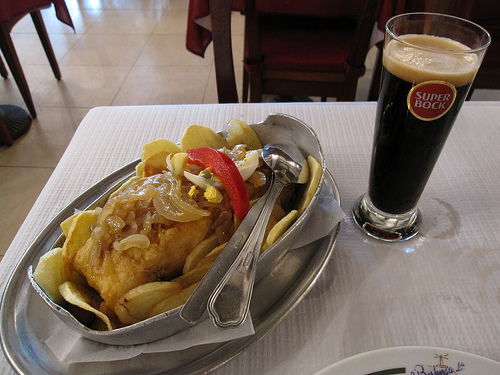
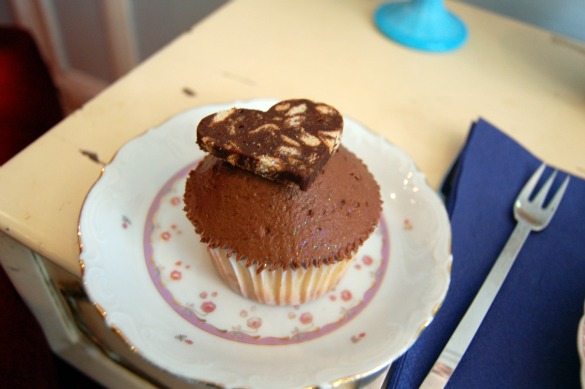 The most typical desserts in Portugal are rice pudding and caramel custard, as well as cheeses (most Portuguese recipes don’t use cheese so it is only eaten before or after the meal). And of course, the most popular pastry is the pastel de nata, a small custard tart sprinkled with cinnamon. For a chocolate treat local to Lisbon, try “chocolate salami.” Melted chocolate is mixed with crushed up cookies, and then dried and sliced so it ends up looking like a slice of salami made of chocolate and cookies. Try it topping a cupcake at
The most typical desserts in Portugal are rice pudding and caramel custard, as well as cheeses (most Portuguese recipes don’t use cheese so it is only eaten before or after the meal). And of course, the most popular pastry is the pastel de nata, a small custard tart sprinkled with cinnamon. For a chocolate treat local to Lisbon, try “chocolate salami.” Melted chocolate is mixed with crushed up cookies, and then dried and sliced so it ends up looking like a slice of salami made of chocolate and cookies. Try it topping a cupcake at  The capital and largest city in Portugal, Lisbon offers plenty to see and do and more then enough activity to fill three to four days (more if you take some day trips). Here are a few ideas for things to do in Lisbon.
The capital and largest city in Portugal, Lisbon offers plenty to see and do and more then enough activity to fill three to four days (more if you take some day trips). Here are a few ideas for things to do in Lisbon.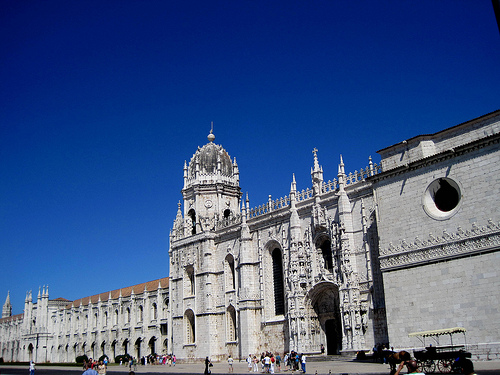 Belém, a parish of Lisbon, sits at the mouth of the Tagus River, six kilometers west of the city center. It’s home to a number of museums and monuments, including the
Belém, a parish of Lisbon, sits at the mouth of the Tagus River, six kilometers west of the city center. It’s home to a number of museums and monuments, including the  While in Belém, don’t miss a stop at the Pastéis de Belém shop just up the street from the Monastery. A pastéis de Belém (or pastéis de nata) is perhaps Portugal’s most famous export. This creamy custard tart can be found all over the country, but many say the best one can still be found at the original shop in Belém. The story goes that the pastéis de natas was created before the 18th century by Catholic nuns at the Jerónimos Monastery. In 1837 the
While in Belém, don’t miss a stop at the Pastéis de Belém shop just up the street from the Monastery. A pastéis de Belém (or pastéis de nata) is perhaps Portugal’s most famous export. This creamy custard tart can be found all over the country, but many say the best one can still be found at the original shop in Belém. The story goes that the pastéis de natas was created before the 18th century by Catholic nuns at the Jerónimos Monastery. In 1837 the  Planning a vacation in England means you’ll be faced with a lot of decisions. London is easy to get to thanks to the many airlines serving its airports and
Planning a vacation in England means you’ll be faced with a lot of decisions. London is easy to get to thanks to the many airlines serving its airports and  When it comes to accommodation choices – especially in a big city where camping might not be an option – you’re generally limited as to the type of place you stay. Sure, you can choose between a hotel, hostel, B&B, apartment, guesthouse or inn, but really these are all just variations on a theme – a building with multiple compartmentalized rooms that offer a bed, a bathroom, and if you’re lucky, access to common room and kitchen.
When it comes to accommodation choices – especially in a big city where camping might not be an option – you’re generally limited as to the type of place you stay. Sure, you can choose between a hotel, hostel, B&B, apartment, guesthouse or inn, but really these are all just variations on a theme – a building with multiple compartmentalized rooms that offer a bed, a bathroom, and if you’re lucky, access to common room and kitchen. In most of Central America, there’s really no other way to get around (unless you want your own rental car) than by bus. The good news about
In most of Central America, there’s really no other way to get around (unless you want your own rental car) than by bus. The good news about 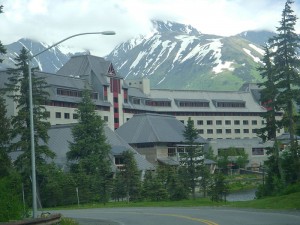 You might expect that with a long, cold winter and abundant snow, Alaska would be covered with snow resorts. But there are surprisingly few all-inclusive ski resorts in the state, and biggest by far is Alyeska Resort in Girdwood. Lying only about 30 miles outside of Anchorage, Alyeska is conveniently located and offers over 1,400 skiable acres of terrain, ranging from the simple to the extremely technical. Although the owners are adding more beginner slopes, there’s a pretty limited number of them now, so if you’re a first-time skier, you won’t have all that many choices. But if you’re comfortable on your skis, Alyeska is a great spot for a ski vacation.
You might expect that with a long, cold winter and abundant snow, Alaska would be covered with snow resorts. But there are surprisingly few all-inclusive ski resorts in the state, and biggest by far is Alyeska Resort in Girdwood. Lying only about 30 miles outside of Anchorage, Alyeska is conveniently located and offers over 1,400 skiable acres of terrain, ranging from the simple to the extremely technical. Although the owners are adding more beginner slopes, there’s a pretty limited number of them now, so if you’re a first-time skier, you won’t have all that many choices. But if you’re comfortable on your skis, Alyeska is a great spot for a ski vacation.
 There are, of course, plenty of great reasons to visit England. It’s an easy first foreign destination for Americans, because a common language makes it accessible. There are typically lots of options on
There are, of course, plenty of great reasons to visit England. It’s an easy first foreign destination for Americans, because a common language makes it accessible. There are typically lots of options on